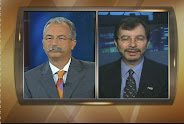DO Fight The Fed
Today, Wall Street's Professional Investor Class (PIC) waits with bated breath for the Fed to provide words of comfort so that one of Wall Street's revered axioms, "don't fight the Fed", will deliver much needed relief to the beleaguered warriors of finance.
One of characteristic of the PICs that is useful to remember is that they are highly reliant on heuristics - rules of thumb that help frame the world into bite-sized analytical pieces. One of the heuristics that has worked from time immemorial is 'don't fight the Fed". For example, last year, around this time, a well-known hedge fund manager advised investors and traders of this well-worn axiom to great effect and result (stocks rose from the fall of 2010 into the summer of 2011). Unfortunately, while the monetary elixir did work its magic on the PICs (they bought stocks), it had little effect on the real economy.
Never sated, the ever-thirsty PICs are back at the don't-fight-the-Fed troff for another hearty slurp of monetary ease = higher risk asset values. From the PICs and Fed's perspectives, the economic rationale for this view is rather simple: Easy money = an increase in the value of risky assets = a positive wealth effect = increase demand = higher GDP (which then = higher wages, increased hiring, etc, etc). Hence, don't fight the Fed ALWAYS delivers. Or does it? And when it does, is the effect always the same under all conditions? Or are the results a product of the economic and financial times?
It may be a risky thing to go against such a dogma. After all, the four most dangerous words in the investment language is "this time is different". And to assume that more easy money will not produce the above listed outcomes is the speak those very dangerous words. Yet, if one believes we are in times that are truly different, particularly in the post WW II era, then perhaps it's time from some fresh perspectives.
Going against such a well-established dogma of day is also especially dangerous given the changed structure of the market. For, when the momo lemmings (who could care less what the drivers are or what direction the markets are headed, just along as stock prices move) jump on the market trend du jour bandwagon, the wheels get turning rather quickly.
Investment Strategy Implications
If you are going to go against a revered heuristic it is useful to have your own heuristic to counter the revered one. My heuristic is this: in a liquidity trap, the effectiveness of monetary policy is limited, at best. Moreover, monetary ease becomes even more limited when fiscal policy is contradtionary (i.e., expansionary austerity). These global macro forces are strong, pervasive, and global in scope.
So, the PICs may rejoice in what they hear today. And risk assets may rise - for a while. But the global macro forces at work can, and I believe will, overwhelm the monetary elixir the Fed will provide. And the PICs don't do global macro very well. (More on this point in a future blog posting.)























